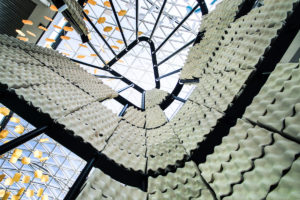Toshiko Mori, Robert P. Hubbard Professor in the Practice of Architecture, is one of 13 new members inducted into the American Academy of Arts and Letters, an honor society of the country’s 250 leading architects, artists, composers, and writers. Each year the academy administers over 70 awards and prizes, exhibits art and manuscripts, funds performances of new works of musical theater, and purchases artwork for donation to museums across the United States.
Francisco “Pancho” Brown (MDes CC ’20) and Angela Mayrina (MDes ADPD ’20) have been selected as New Museum/IdeasCity Singapore 2020 Fellows. They traveled to Singapore this month to attend the NTU CCA Ideas Fest 2019–20, which examined the impact of climate change on communities worldwide. The event also featured student work from the fall 2019 GSD course “Exhibit: Designing for Decentralization,” led by Malkit Shoshan, Area Head of the Art, Design, and the Public Domain MDes group. The advanced research- and project-based course was held in collaboration with IdeasCity, the New Museum’s platform to explore art and culture beyond the walls of the museum.


The Material Processes and Systems (MaP+S) Group presented “Ceramic Morphologies” at Cevisama 2020 in Valencia, Spain. The pavilion showcased the expressive potential of ceramic 3D printing, and tested the adaptation of principles of thermodynamic heat transfer to 3D printed geometry. The shape and design of the pavilion were products of current research related to the thermal performance of naturally ventilated spaces. While the exterior surface was smooth and uniform, the interior surface was heavily contoured and textured. MaP+S also displayed “Ceramic Prototype: Hypar Tower” at Cevisama. It explored the structural capabilities of slender ceramic extrusions—products commonly utilized for exterior claddings, rain screens, and sun-shading elements.
An exhibition designed by Stanislas Chaillou (MArch ’19)—and featuring work from his GSD thesis—is displayed at Paris’s Pavillon de l’Arsenal. According to the exhibition website, “The ‘AI & Architecture’ exhibition takes us through the main stages of an evolution that started from the studies on Modularity, Computer-aided Design (CAD), Parametrics and, finally, Artificial Intelligence.” Bringing together research and practice, “it also explores the current scales of experimentation: plans, elevations, structures and perspectives in which AI could already make a contribution, real or speculative.” “AI & Architecture” will be on view through April 5, 2020.

Honghao Deng’s (MDes ’18) thesis, “Diffusive Geometries,” advised by assistant professor of architectural technology Panagiotis Michalatos, won the Core77 Built Environment Award. “Diffusive Geometries” explores vapor as a medium to bring microclimates that exist outside into architectural space. The unique characteristics of vapor allow users to modulate visibility, create cooling gradients, and produce spatial patterns in a controlled manner. The Core77 Awards received more than 10,000 entries and selected just one student/professional winner in the built environment category. This is the second time a GSD student won, and the first win for the MDes program.
